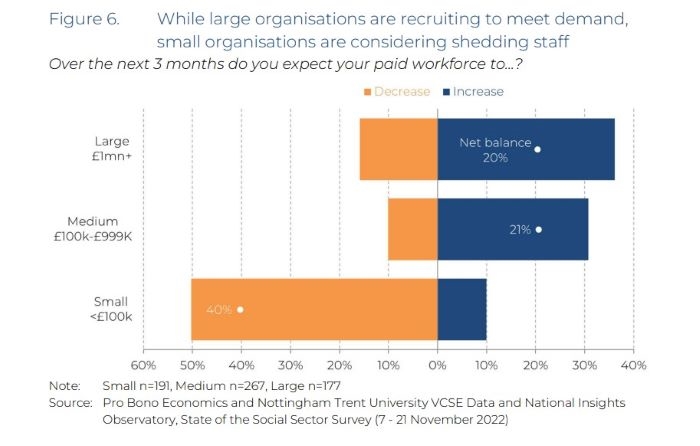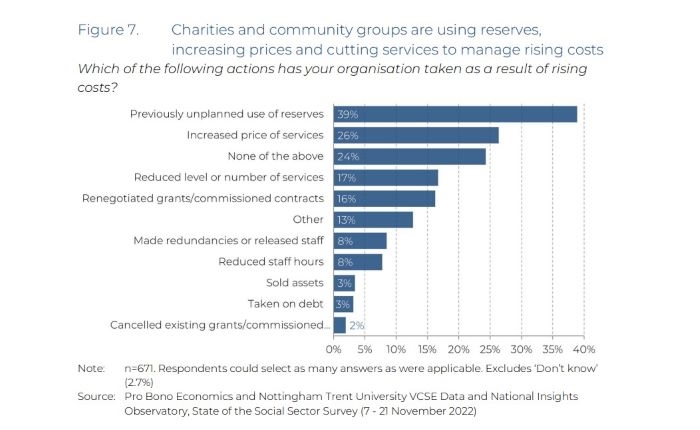New research shows that charities and community groups are now facing a very difficult winter and some very hard choices. Pro Bono Economics and Nottingham Business School share the results from their latest sector survey.

Elevated and protracted demand for charitable services is beginning to overwhelm many organisations, according to research published by Pro Bono Economics and Nottingham Business School.
The results of the State of the Sector Survey show that half (49%) of charities and community groups expect demand for their services over winter to exceed their ability to meet it. And almost one in five charitable organisations expect to fall significantly short in their ability to meet demand.
A net balance of seven in ten (71%) charities and community groups report that they have experienced an increase in demand over the three months to November, with four in ten (41%) reporting that demand has increased a lot.
One of the most troubling statistics to come out of the research is that 41% are being forced to cut services. That ultimately means less support for people who need it.
Staffing and resource management
A net balance of one in five large (20%) and medium-sized (21%) charities and community groups report that their intention is to increase the size of their paid workforce over the next three months.
A third (33%) of large charities and community groups say they have already increased their paid staff teams in the three months to November, and 13% of medium-sized organisations reported the same.
However, more than a third of charities (36%) are struggling to fill vacancies and charity staff are having to work longer hours to plug the skills gap and keep up. But doing so is not sustainable after almost three years of running at pace.
More staff means a larger cost base to fund, and a substantial proportion of charitable organisations have experienced a deterioration in their financial positions over the past three months, with many more anticipating further deterioration to come.
This financial stress is of such a scale that a majority of charities and community groups are now using their reserves in order to meet their operating costs.
Smalls under pressure
Small charities and community groups are particularly vulnerable and the research shows that they are more likely than any other group to be experiencing financial difficulty.
More than one in four (27%) have been forced to reduce the number of paid staff in their employ over the past three months.
Further reductions are anticipated over winter, with 40% saying that they expect to see a decrease in their paid workforce.
A net balance of more than one in four (27%) have been forced to reduce the number of paid staff in their employ over the past three months – with further reductions anticipated over winter.

What are charities doing about it?
Charities and community groups are pulling on a variety of levers to remain financially and operationally sustainable, just as they did during the Covid-19 pandemic.
More than a third are using reserves they hadn't planned to dip into, and a quarter have increased the price of their services.
However, as the report points out, not all charities are in a position to raise prices and many have much less ability to absorb future price rises, such as further increasing energy bills.
Nearly a quarter (23%) of charities which pay for energy directly are on fixed electricity and/or gas rates that will expire by the end of March 2023, and will therefore soon be experiencing additional costs.
One in five charities (20%) are on variable rates for their gas, electricity or both and will therefore be additionally vulnerable once government discounts for charities’ energy costs cease.
A fifth of charities has reduced the use of their premises as a result of energy costs, and just under one in ten (8%) have reduced their hours of operation.

Conclusions
The situation now being experienced by charities and community groups requires an urgent response from funders, regulators and government. This data makes a strong case that the safety net is not just fraying, but that parts of it have snapped.
The report concludes: 'Government must act to reduce demand, with support for those on the lowest incomes and investment to reduce backlogs. And alongside funders and regulators, it must act to shore up the social sector’s resilience if it is to continue acting as the essential source of support it is for so many.'
Caron Bradshaw OBE, CEO of CFG, comments:
“We are pleased to once again support Pro Bono Economics and Nottingham Business School in their sector research. The results of the survey – which many of CFG’s members kindly responded to – evidences what we are hearing anecdotally from our members and other charitable organisations across the country.
“We are hearing time and again that charities and charitable groups are bracing themselves for a very difficult winter ahead. It is, of course, deeply worrying that so many charitable organisations are looking to reduce their services and workforce and in many cases already have.
"Our sector not only supports people in their hours of need, but also makes an enormous contribution to the rich fabric of society. When charities and community groups struggle to meet demand and make ends meet, it’s all of society that feels the impact.
"We would urge those struggling organisations to reach out to infrastructure bodies like CFG to tap into the wealth of knowledge and experience that can be found in our networks. Those that are doing all they can to hold their charities together do not have to face this alone. This sector is all about the support it provides to others and it is generous in what it shares and gives. Do not be alone - reach out.”
Read the full analysis of the State of the Sector survey
Find practical support and guidance in our Cost of Living Hub